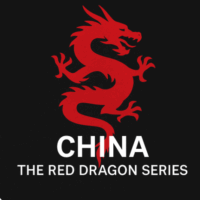 The Gathering Storm Series: Part 9 – The Dragon’s Coin: Breaking the Dollar, Buying the World
The Gathering Storm Series: Part 9 – The Dragon’s Coin: Breaking the Dollar, Buying the World
Follow the Coin
Empires do not rise with gunfire. They rise on coin. On trade. On control of what the world needs—and who gets it. That was the essence of mercantilism centuries ago. And it is the beating heart of China’s modern empire now.
In the 17th and 18th centuries, imperial powers amassed wealth by exporting goods, hoarding gold, and enslaving labor. Colonies existed not to flourish, but to feed the center. London. Paris. Madrid. They built navy fleets, paid with coin wrung from captive markets and human backs. Mercantilism was not economics. It was power dressed in trade.
Today, China is playing the same game—with updated tools.
Three Pillars of Modern Mercantilism
- Export Supremacy
China floods the world with steel, solar panels, rare earths, electronics, pharmaceuticals, drones, and now cars. It sells. The rest of the world buys. In 2023, the U.S. trade deficit with China stood at nearly $295 billion—a drain of capital and sovereignty, dollar by dollar. - Currency and Gold Reserves
The profits from these exports do not just sit idle. They return as hard assets and gold. China has bought over 2,000 metric tons of gold since 2019, becoming the largest official buyer on the planet. The goal: undermine the dollar, anchor the yuan, and prepare for a post-dollar world. This is not speculation. It is design. - Vassal-State Supply Chains
Instead of enslaving through chains, Beijing enslaves through contracts. Belt and Road projects now span 148 countries, binding ports, mines, and transport hubs to Chinese financing and military access. Sri Lanka. Pakistan. Kenya. Argentina. Laos. Each a spoke in a wheel they do not own.
Ports and Petroleum, Bought and Buried
Beijing has built naval-accessible ports in Djibouti, Gwadar (Pakistan), Lamu (Kenya), and Hambantota (Sri Lanka)—all through “debt diplomacy” disguised as development. The Chinese navy does not yet rival the U.S. in aircraft carriers, but in hulls, shipbuilding, and presence, it is already the largest. It produces more than 20 warships per year and has six full-capacity shipyards operating around the clock.
In the energy arena, China buys oil and coal without concern for pollution. Deals with Venezuela, Iran, Russia, and Angola ensure the dragon stays fed—even if the planet chokes. Climate treaties mean little when your factories run on lignite and your skies hide your satellites.
The Dollar in the Crosshairs
Every BRICS summit now whispers about the “de-dollarization” agenda. Brazil and China completed their first cross-border transactions in yuan last year. Russia now settles most oil sales with India in rupees or yuan. Saudi Arabia—once a petrodollar anchor—is in talks with China for yuan-denominated oil contracts.
At stake is not just pride. It is primacy. If the dollar ceases to be the world’s reserve currency, America will no longer export stability. It will import inflation.
How Did We Get Here?
We gave them the leverage. We outsourced. We shut down mines, plants, and mills. We let them steal IP, evade tariffs, and dump goods at a loss. We told ourselves it was cheaper. It was not. It was surrender on a five-year payment plan.
Our critical minerals? 80% sourced from China.
Our antibiotics? 90% of active ingredients originate in Chinese plants.
Our solar panels? 96% of polysilicon traced back to Chinese labor, including from Xinjiang.
This is not a trade partnership. It is entanglement with a regime that weaponizes dependence.
We Must Break the Chain
So what must we do?
- Reshore strategic industries—not to build nostalgia, but to build survival.
- Stockpile rare earths, gold, and critical materials as nations once stockpiled grain.
- Restore manufacturing pride in steel, semiconductors, and shipbuilding.
- Forge new alliances—India, Poland, Mexico, Vietnam—nations with people ready to work, and governments tired of being pawns.
Trade must serve the nation, not strip it. The Founders understood that independence meant more than flags. It meant making things.
Final Thought
The dragon is not hoarding gold for sport. It is not controlling ports for prestige. It is not building warships for decoration. It is planning to rule in the currency of empire.
And that is not a currency we should accept.
“The true cost of cheap goods is freedom leased out—one container at a time.”
Note to Readers – Part 9
I set out to write seven or eight parts. That was the plan. But Communist China keeps rewriting the threat map. Each week, another pressure point. Another turn of the screw.
So here is Part 9. Because the storm isn’t passing—it’s gathering.
And there’s more coming. Future updates will be marked Coda—single stories worth tracking. Flashpoints. Fault lines. Signs the Red Dragon is still circling the globe, eyes locked on us. Watching. Waiting. Pressing forward.
We need to stay alert. The threat isn’t theoretical anymore.
Keywords: The Gathering Storm Series, modern mercantilism, China, gold reserves, BRICS, de-dollarization, rare earths, Belt and Road Initiative, trade deficits, manufacturing, supply chains, ports, global influence, economic sovereignty, energy trade, U.S. response.